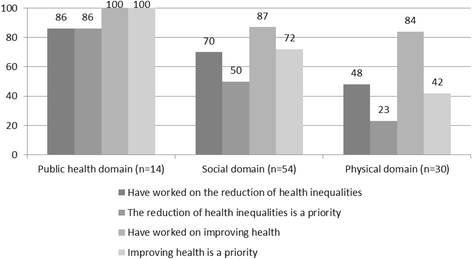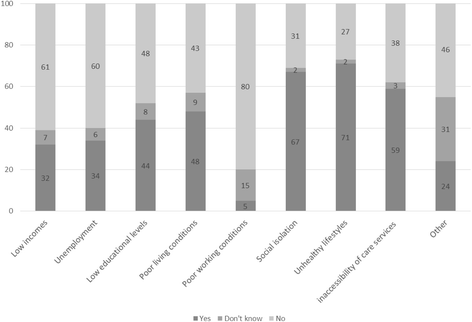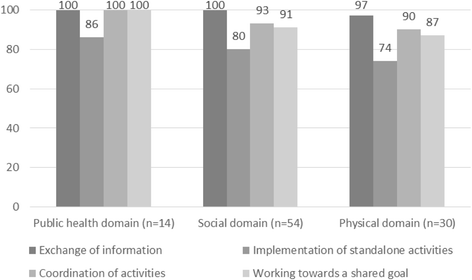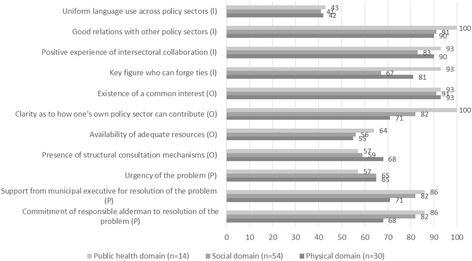How to improve collaboration between the public health sector and other policy sectors to reduce health inequalities? - A study in sixteen municipalities in the Netherlands
- PMID: 27334297
- PMCID: PMC4918104
- DOI: 10.1186/s12939-016-0384-y
How to improve collaboration between the public health sector and other policy sectors to reduce health inequalities? - A study in sixteen municipalities in the Netherlands
Abstract
Background: The causes of health inequalities are complex. For the reduction of health inequalities, intersectoral collaboration between the public health sector and both social policy sectors (e.g. youth affairs, education) and physical policy sectors (e.g. housing, spatial planning) is essential, but in local practice difficult to realize. The aim of this study was to examine the collaboration between the sectors in question more closely and to identify opportunities for improvement.
Method: A qualitative descriptive analysis of five aspects of collaboration within sixteen Dutch municipalities was performed to examine the collaboration between the public health sector and other policy sectors: 1) involvement of the sectors in the public health policy network, 2) harmonisation of objectives, 3) use of policies by the relevant sectors, 4) formalised collaboration, and 5) previous experience. Empirical data on these collaboration aspects were collected based on document analysis, questionnaires and interviews.
Results: The study found that the policy workers of social sectors were more involved in the public health network and more frequently supported the objectives in the field of health inequality reduction. Both social policy sectors and physical policy sectors used policies and activities to reduce health inequalities. More is done to influence the determinants of health inequality through policies aimed at lifestyle and social setting than through policies aimed at socioeconomic factors and the physical environment. Where the physical policy sectors are involved in the public health network, the collaboration follows a very similar pattern as with the social policy sectors. All sectors recognise the importance of good relationships, positive experiences, a common interest in working together and coordinated mechanisms.
Conclusion: This study shows that there is scope for improving collaboration in the field of health inequality reduction between the public health sector and both social policy sectors and physical policy sectors. Ways in which improvement could be realised include involving physical policy sectors in the network, pursuing widely supported policy goals, making balanced efforts to influence determinants of health inequalities, and increasing the emphasis on a programmatic approach.
Keywords: Health in All Policies (HiAP); Health inequalities; Intersectoral collaboration; Physical sectors; Public health; Social sectors.
Figures





Similar articles
-
Opportunities to reduce health inequalities by 'Health in All Policies' in the Netherlands: an explorative study on the national level.Health Policy. 2011 Dec;103(2-3):130-40. doi: 10.1016/j.healthpol.2011.09.009. Epub 2011 Oct 22. Health Policy. 2011. PMID: 22019297
-
Measuring stages of health in all policies on a local level: the applicability of a maturity model.Health Policy. 2014 Feb;114(2-3):183-91. doi: 10.1016/j.healthpol.2013.05.006. Epub 2013 Jun 12. Health Policy. 2014. PMID: 23764153
-
Cross-sector collaboration to reduce health inequalities: a qualitative study of local collaboration between health care, social services, and other sectors under health system reforms in England.BMC Public Health. 2024 Sep 27;24(1):2613. doi: 10.1186/s12889-024-20089-5. BMC Public Health. 2024. PMID: 39334058 Free PMC article.
-
[The Common Risk Factor Approach - An Integrated Population- and Evidence-Based Approach for Reducing Social Inequalities in Oral Health].Gesundheitswesen. 2016 Oct;78(10):672-677. doi: 10.1055/s-0035-1548933. Epub 2015 Sep 3. Gesundheitswesen. 2016. PMID: 26335657 Review. German.
-
Making Health for All Policies: Harnessing the co-benefits of health [Internet].Copenhagen (Denmark): European Observatory on Health Systems and Policies; 2023. Copenhagen (Denmark): European Observatory on Health Systems and Policies; 2023. PMID: 37579035 Free Books & Documents. Review.
Cited by
-
A fuzzy decision support model for the evaluation and selection of healthcare projects in the framework of competition.Front Public Health. 2023 Aug 8;11:1222125. doi: 10.3389/fpubh.2023.1222125. eCollection 2023. Front Public Health. 2023. PMID: 37614458 Free PMC article.
-
Study protocol: evaluation of a community health promotion program in a socioeconomically deprived city district in the Netherlands using mixed methods and guided by action research.BMC Public Health. 2019 Jan 16;19(1):72. doi: 10.1186/s12889-019-6389-x. BMC Public Health. 2019. PMID: 30651093 Free PMC article.
-
A toolkit with nine district types to support municipalities in taking an integrated approach to prevention.Arch Public Health. 2019 Dec 19;77:56. doi: 10.1186/s13690-019-0378-5. eCollection 2019. Arch Public Health. 2019. PMID: 31890205 Free PMC article.
-
Theory-based capacity building intervention for intersectoral action for health at local governments: An exploratory pilot study.J Adv Nurs. 2022 Jun;78(6):1798-1814. doi: 10.1111/jan.15247. Epub 2022 Apr 18. J Adv Nurs. 2022. PMID: 35436006 Free PMC article.
-
Identification of Network Promoters in a Regional and Intersectoral Health Promotion Network: A Qualitative Social Network Analysis in Southern Germany.Int J Environ Res Public Health. 2021 Aug 7;18(16):8372. doi: 10.3390/ijerph18168372. Int J Environ Res Public Health. 2021. PMID: 34444123 Free PMC article.
References
-
- Schrijvers CTM, Storm I. Naar een integrale aanpak van gezondheidsachterstanden. Een beschrijving van beleidsmaatregelen binnen en buiten de volksgezondheidssector [Towards an integrated approach for tackling health inequalities. RIVM: Bilthoven; 2009.
-
- RIVM . Towards a healthier Netherlands. Key findings of the Dutch Public Health Status and Foresight study (PHSF) Bilthoven: National Institute for Public Health and the Environment (RIVM); 2014.
-
- Pharos, Platform31. Stimuleringsprogramma Gezond in de stad (GIDS) [National support programme Health in the city] http://www.gezondin.nu/. Accessed oktober 2015.
-
- Dahlgren G, Whitehead M. Leveling up Part 2: a discussion on European strategies for tackling social inequities in health. Copenhagen: World Health Organization Regional Office for Europe; 2006.
Publication types
MeSH terms
LinkOut - more resources
Full Text Sources
Other Literature Sources
Medical

